Lockers, Bins & Compartments
by Paul Butler
illustrations by Marya Butler
All boats benefit from an abundance of storage compartments, lockers, and bins. What many boaters don't realize, however, is that these compartments can serve other functions as well. On small boats carefully constructed watertight compartments can provide flotation should the hull swamp, and they can even
help reinforce the hull.
Below-Deck Compartments
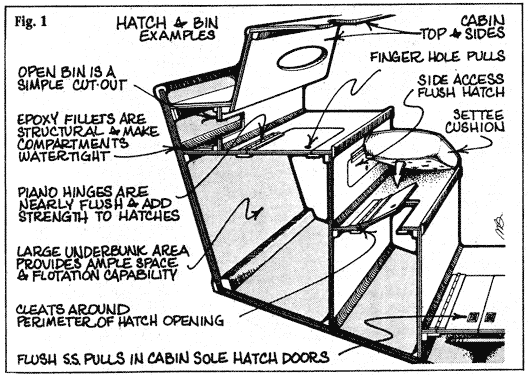
Ideally, below-deck lockers and compartments should be watertight, not only to keep their contents dry but also to provide flotatlon If needed (Fig. 1). Sealing compartments inside and out with epoxy resin and applying epoxy fillets along the seams ensures watertightness. The fillets also form a structural bond between the compartment and the hull, adding to overall hull strength. Tightly sealed compartments are no problem to construct in cold-molded and fiberglass hulls. But moisture in the wood may make sealing difficult on a traditional plank-on-frame hull.The way around this problem is to construct modular compartments and attach them to the framing with bolts or screws.
Access to cabin compartments requires some forethought. To get maximum fiotation from compartments extending above the waterline, you will need to locate openings on or near the top. For compartments placed low in the hull, completely watertight access is possible with the use of easy-to-install screw-in hatch covers.
Access should also be planned around the items that will be stored in each space and the size of the boat. Under bunk areas, often the largest compartments on a small boat, are ideal for storing personal belongings. These large areas may be divided into small compartments to isolate or separate gear. For structural reasons, the hatches should be reasonably small, but nothing is worse than an undersized opening through which only a few items will fit. If you plan on stashing an extra boathook or spare dinghy oars here, you will have to provide adequate space to maneuver them in and out. We often cut round-cornered hatches for aesthetics, but they can also be patterned to accommodate odd-shaped items.
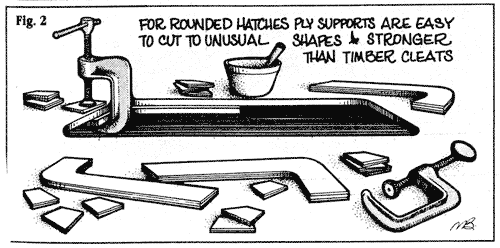
Flush-fitting hatchcovers are easy to build (see article) and won't catch toes, clothes, lines, or other gear. Flush hatchcovers are difficult to make watertight and so are best suited to self-draining cockpit hatches, interior bunktops, or soles. Such hatchcovers should be supported around their entire perimeter by hardwood or plywood cleats glued to the underside of the opening with epoxy. For rounded hatches, plywood supports are easier to cut to unusual shapes and stronger than timber cleats. We normally leave a 1/2-inch lip inside the hatch with 1-1/2 inches for the glue joint. These supports must take a lot of weight, especially when used on seats or bunks, and they should be reinforced with screws or bolts if used on deck or in cockpits (Fig. 2). Piano hinges add Considerable strength to flimsy hatch covers; since they are flat, they may also be acceptable for bunk bottoms and under settee cushions.

For cabin soles and similar applications, the hatchcover may be left without hinges. Liftup hardware can be recessed flush, though a simpler alternative is a plain 1-inch fingerhole drilled through the hatchcover and routed smooth on corners, top, and bottom. These covers can be secured by one or more plywood toggles (Fig. 3). Covers removed only occasionally can be secured with waxed Phillips head screws countersunk flush. The wax makes the screws easier to drive in and out.
Bins are very simple compartments, sometimes without hatches or doors, and can carry an abundance of gear. Some open bins are just a series of compartments or "pigeon holes" built against the hull; others have outboard-leaning bottoms and a large hole for access. Openings maybe cut to accommodate a particular size or shape of gear.
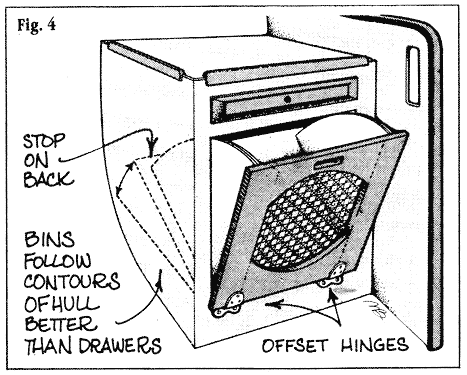
Triangular drop-out bins, sometimes called galley bins because they are ideally suited for galleys, use space more efficiently and support more weight than sliding drawers. They also become more stable as the load gets heavier. Installed near the sole, they can serve as home for often used items like flour grains flatware, plates, or pots and pans. They're easy to build and, other than a pair of hinges or some type of positive closure, they require little hardware (Fig. 4).
Deck Compartments
Deck compartments regularly exposed to rain and spray are difficult to make watertight. It can be done, even with flush-fitting hatchcovers, but involves building in a gutter drain with attached plumbing system or the use of gasket material that never seems to function as well as it should, lf watertight hatches are required, they are best made in the traditional way, with a raised top that fits snugly over coamings. If clearance is a problem, the coamings may be made very short. It's possible to make a small-boat hatch that stands less than an inch off the deck or sole and still sheds spray and rainwater.
It's best to make deck compartments self-draining. Drain holes should be located at each corner of the compartment, or the compartment bottom should be angled toward the direction of the drain holes. The holes don't have to be large, but they should be flush with the sole and well sealed with epoxy. Anchor lockers in the bow are usually drained outboard through the hull, and cockpit lockers that function as seats usually drain inboard onto the cockpit sole and overboard through the transom.
Because of eventual water absorption and the potential for rot, this latter drainage method could cause problems with traditionally built hulls unless the wood is kept well oiled (with boiled linseed oil or a linseed oil-based Finish) and the compartment well ventilated. Cold-molded and fiberglass hulls avoid this problem with liberal use of epoxy resin, fiberglass sheathing, and epoxy fillets. A well-sealed locker interior with abrasion-resistant sheathing and large radius fillets to aid in cleaning will last for years without maintenance of any kind, particularly since the compartment is closed most of the time and therefore shielded from potentially harmful sunlight. The locker may be painted for more protection and a more finished appearance.
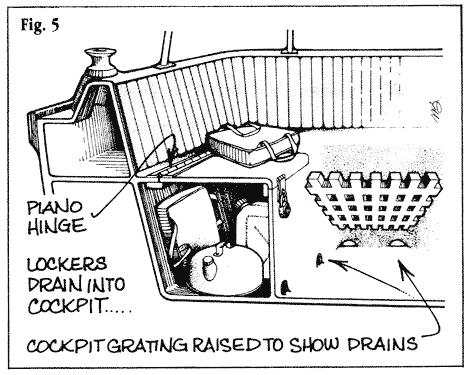
Watertight bulkheads should always divide cockpit lockers from the rest of the boat. And since they are self bailing, they are ideal for storing fuel and other fiammables. Any unexpected or undiscovered leakage is washed overboard instead of into the bilges. Grates inside the compartment are very useful to keep gas cans off the wet bottom, and with an additional grating in the cockpit as well, the spill will flow out unnoticed (Fig 5).
If the cockpit hatchcovers double as seats, and if room allows, the back sides can also be lockers, constructed at a comfortable backrest angle and made watertight or self-draining. This makes a handy accessible space for small items often needed in the cockpit. Many cockpit lockers are provided with a lock of some type to make them easy to secure when leaving the boat.
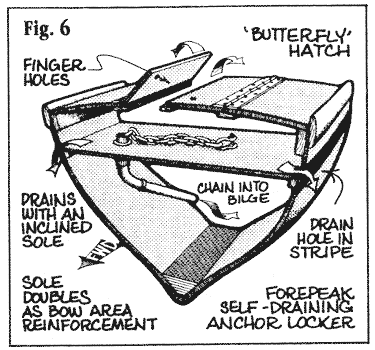
A self-draining anchor locker in the forepeak is the perfect place to stow a "ready" anchor system, which can be reached in a hurry from topside, as well as fenders, winch handles, and other deck gear. The locker can be built of plywood into a wood, fiberglass, or metal hull and fitted with a flush-fitting hatch to keep the deck flat and free of obstructions. The sides should extend right up to the sides of the hull, where holes are bored for drainage, and the bottom canted toward the drain holes. The holes can be sealed with epoxy, or bronze or plastic through-hull fittings can be used (Fig. 6).
A two-piece "butterfly" hatch using bronze or stainless piano hinges is ideal here, and if the fastening screws are dipped in epoxy, they'll hold better, last longer, and keep the wood healthier. Stainless self-tapping screws maybe preferable for fiberglass decks. In addition to support cleats glued and screwed around the opening, a centerline support maybe necessary for large hatches.
This article is excerpted from a book on modifying small
sailboats for cruising - published by International Marine